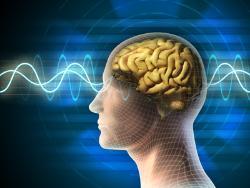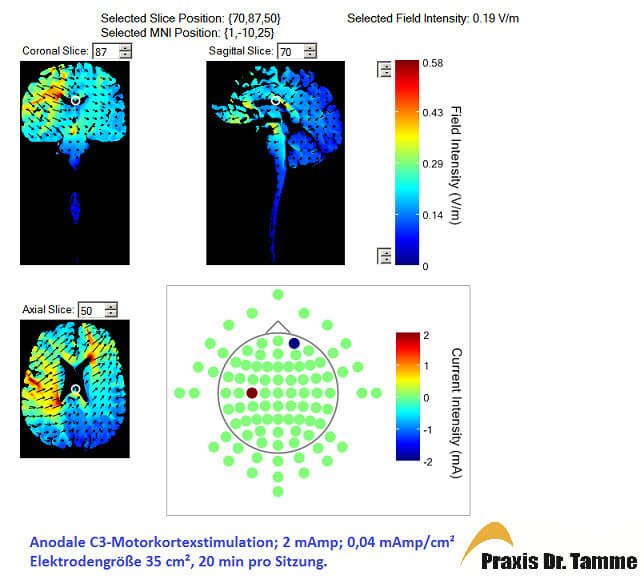tDCS
TRANSKRANIELLE GLEICHSTROMSTIMULATION (tDCS = TRANSCRANIAL DIRECT CURRENT STIMULATION)
Funktionsweise
Bei der transkraniellen Gleichstromstimulation (tDCS) wirkt über zwei an der Kopfhaut aufgelegte Flächenelektroden ein schwacher und nicht spürbarer elektrischer Strom durch den Schädelknochen hindurch (transkraniell) auf das Gehirn. Er verändert die Erregbarkeit der Nervenzellen, wodurch sich Hirnareale gezielt in Ihrer Aktivität anregen (wenn die zugrunde liegende Erkrankung mit Minderaktivität verbunden ist, z.B. bei der Depression) oder dämpfen lassen (wenn die zugrunde liegende Erkrankung mit vermehrter Hirnaktivität verbunden ist, z.B. bei der Migräne).
Elektrische Rationale: man spricht von einer anodalen (anregenden) Stimulation, wenn das Membranpotential des Neurons unter der Anode durch Depolarisation von 65 mV auf etwa 55 mV depolarisiert wird (wodurch sich Reize leichter auslösen lassen) und von einer kathodalen (dämpfenden) tDCS-Wirkung, wenn das Neuron unter der Kathode hyperpolarisiert wird, (wodurch sich Aktionspotentiale schwerer auslösen lassen).
Transmitter-Rationale: Die Anode reduziert die GABA-erge Aktivität des Neurons und sorgt damit für erleichterte Erregbarkeit, die Kathode reduziert die glutamaterge Aktivität und dämpft dadurch die Erregbarkeit.

Durchführung
Die angestrebte Wirkung der tDCS wird bestimmt durch Größe und Positionierung der beiden Flächenelektroden. Die Behandlungen dauern 10 oder 20 Minuten. Was bei medikamentöser Therapie Dosierung und Einnahmehäufigkeit darstellen, sind bei Anwendung der tDCS die Stimulationsparameter. In der Vergangenheit wurden verschiedene Parameter auf ihre Wirksamkeit hin untersucht, wobei insbesondere die Faktoren Frequenz, Intensität, Gesamtzahl der Stimuli, Ort der Applikation eine Rolle spielen. Empirisch begründete Parameter ergeben sich aus den verschiedenen Studien. Insgesamt kristallisieren sich nach Nitsche et al. (2003) als determinierende Faktoren heraus:
- Stromdichte (Stimulationsstärke (A)/Elektrodengröße (cm2))
- Gesamtladung (Stromstärke/Elektrodengröße x Stimulationsdauer)
- Ladung pro Phase (Stromstärke x Dauer eines Einzelimpulses)
- Ladungsdichte (Stromstärke/Elektrodengröße x Dauer eines Einzelimpulses)
Einsatzgebiete
Wir setzen tDCS bei chronischen Schmerzen, z.B. beim Fibromyalgiesyndrom, und bei Depressionen ein. Außerdem kommt tDCS regelmäßig bei der Migräneprophylaxe zur Anwendung, wenn es gilt, jenseits der medikamentösen Therapie, die zuweilen als sehr belastend, Nebenwirkungs-behaftet und nur dürftig wirksam empfunden wird, eine nebenwirkungsfreie Hilfe zu bekommen. In der Neurologie findet tDCS Anwendung bei der Behandlung der Epilepsie, bei Morbus Parkinson, bei Multipler Sklerose, Spastik und Rehabilitation nach Schlaganfall.

Sicherheit und Nebenwirkungen
Die tDCS wird ambulant und ohne Begleitmedikation durchgeführt, da die Behandlung gut vertragen wird und keine Beeinträchtigungen, unangenehme Nebenwirkungen oder Risiken zu befürchten sind. Mehrere Studien zur Sicherheit der tDCS und zur Evaluation der Nebenwirkungen haben zu klaren Empfehlungen hinsichtlich der sicheren Anwendung geführt. Übereinkunft besteht, dass die tDCS bei Beachtung der Richtlinien hinsichtlich Kontraindikationen und Stimulationsparameter eine gut verträgliche und nebenwirkungsarme Methode ist (Nitsche et al. 2003, Fregni et al. 2006, Iyer et al. 2005): es können keine Krampfanfälle ausgelöst werden. Nur selten werden leichte Müdigkeit oder Übelkeit geklagt, die aber von alleine nach kurzer Zeit abklingen. Es können elektrisch induzierte lokale Muskelkontraktionen während der Stimulation auftreten, verbunden mit einer Reizung der Kopfhaut, was als Kribbeln und Ziehen beschrieben wurde (Fregni et al. 2006). Gewebeschäden wurden auch nach hohen Stimulusintensitäten und -frequenzen nie beobachtet.

Welche Kosten kommen auf mich zu?
tDCS-Neuromodulation wird gemäß §12 des Sozialgesetzbuches nicht von den gesetzlichen Krankenkassen übernommen, ist aber dennoch als individuelle Gesundheitsleistung (IGEL) bezahlbar. Eine Behandlungssitzung kostet bei Ansetzen der GOÄ-Analogziffer 832a (3,5-facher Satz) 32,23 €. Wir gehen von 10 bis 15 Sitzungen aus. Einige private Krankenversicherungen erstatten die tDCS-Behandlung.
Wissenschaftliche Publikationen:
1 Arul-Anandam, A. P. & Loo, C. Transcranial direct current stimulation: a new tool for the treatment of depression? J. Affect. Disord.117, 137-145, doi:10.1016/j.jad.2009.01.016 (2009).
2 Brunoni, A. R. et al. A systematic review on reporting and assessment of adverse effects associated with transcranial direct current stimulation. Int. J. Neuropsychopharmacol.14, 1133-1145, doi:10.1017/s1461145710001690 (2011).
3 Brunoni, A. R. et al. Clinical research with transcranial direct current stimulation (tDCS): challenges and future directions. Brain stimulation5, 175-195, doi:10.1016/j.brs.2011.03.002 (2012).
4 Kuo, M. F., Paulus, W. & Nitsche, M. A. Therapeutic effects of non-invasive brain stimulation with direct currents (tDCS) in neuropsychiatric diseases. Neuroimage85 Pt 3, 948-960, doi:10.1016/j.neuroimage.2013.05.117 (2014).
5 Shin, Y. I., Foerster, A. & Nitsche, M. A. Transcranial direct current stimulation (tDCS) – Application in neuropsychology. Neuropsychologia69c, 154-175, doi:10.1016/j.neuropsychologia.2015.02.002 (2015).
6 Medeiros, L. F. et al. Neurobiological effects of transcranial direct current stimulation: a review. Frontiers in psychiatry3, 110, doi:10.3389/fpsyt.2012.00110 (2012).
7 Shiozawa, P. et al. Transcranial direct current stimulation for major depression: an updated systematic review and meta-analysis. Int. J. Neuropsychopharmacol.17, 1443-1452, doi:10.1017/s1461145714000418 (2014).
6 Medeiros, L. F. et al. Neurobiological effects of transcranial direct current stimulation: a review. Frontiers in psychiatry3, 110, doi:10.3389/fpsyt.2012.00110 (2012).
8 Borckardt, J. J. et al. A pilot study of the tolerability and effects of high-definition transcranial direct current stimulation (HD-tDCS) on pain perception. J. Pain13, 112-120, doi:10.1016/j.jpain.2011.07.001 (2012).
9 Clancy, J. A., Johnson, R., Raw, R., Deuchars, S. A. & Deuchars, J. Anodal transcranial direct current stimulation (tDCS) over the motor cortex increases sympathetic nerve activity. Brain stimulation7, 97-104, doi:10.1016/j.brs.2013.08.005 (2014).
10 DaSilva, A. F., Volz, M. S., Bikson, M. & Fregni, F. Electrode positioning and montage in transcranial direct current stimulation. Journal of visualized experiments : JoVE, doi:10.3791/2744 (2011).
11 Datta, A. et al. Gyri-precise head model of transcranial direct current stimulation: improved spatial focality using a ring electrode versus conventional rectangular pad. Brain stimulation2, 201-207, 207.e201, doi:10.1016/j.brs.2009.03.005 (2009).
12 DosSantos, M. F. et al. Immediate effects of tDCS on the mu-opioid system of a chronic pain patient. Frontiers in psychiatry3, 93, doi:10.3389/fpsyt.2012.00093 (2012).
13 Krause, B., Marquez-Ruiz, J. & Cohen Kadosh, R. The effect of transcranial direct current stimulation: a role for cortical excitation/inhibition balance? Front. Hum. Neurosci.7, 602, doi:10.3389/fnhum.2013.00602 (2013).
14 Kuo, H. I. et al. Comparing cortical plasticity induced by conventional and high-definition 4 x 1 ring tDCS: a neurophysiological study. Brain stimulation6, 644-648, doi:10.1016/j.brs.2012.09.010 (2013).
15 Nitsche, M. A. et al. Transcranial direct current stimulation: State of the art 2008. Brain stimulation1, 206-223, doi:10.1016/j.brs.2008.06.004 (2008).
16 Opitz, A., Paulus, W., Will, S., Antunes, A. & Thielscher, A. Determinants of the electric field during transcranial direct current stimulation. Neuroimage109, 140-150, doi:10.1016/j.neuroimage.2015.01.033 (2015).
17 Pelletier, S. J. & Cicchetti, F. Cellular and Molecular Mechanisms of Action of Transcranial Direct Current Stimulation: Evidence from In Vitro and In Vivo Models. Int. J. Neuropsychopharmacol.18, doi:10.1093/ijnp/pyu047 (2014).
18 Rahman, A. et al. Cellular effects of acute direct current stimulation: somatic and synaptic terminal effects. J. Physiol.591, 2563-2578, doi:10.1113/jphysiol.2012.247171 (2013).
19 Sadleir, R. J., Vannorsdall, T. D., Schretlen, D. J. & Gordon, B. Target optimization in transcranial direct current stimulation. Frontiers in psychiatry3, 90, doi:10.3389/fpsyt.2012.00090 (2012).
20 Villamar, M. F. et al. Technique and considerations in the use of 4×1 ring high-definition transcranial direct current stimulation (HD-tDCS). Journal of visualized experiments : JoVE, e50309, doi:10.3791/50309 (2013).
20 Villamar, M. F. et al. Technique and considerations in the use of 4×1 ring high-definition transcranial direct current stimulation (HD-tDCS). Journal of visualized experiments : JoVE, e50309, doi:10.3791/50309 (2013).
21 Hazime, F. et al. Analgesic efficacy of cerebral and peripheral electrical stimulation in chronic nonspecific low back pain: a randomized, double-blind, factorial clinical trial. BMC Musculoskelet. Disord.16, 7, doi:10.1186/s12891-015-0461-1 (2015).
22 Kim, Y. J. et al. Randomized, sham controlled trial of transcranial direct current stimulation for painful diabetic polyneuropathy. Annals of rehabilitation medicine37, 766-776, doi:10.5535/arm.2013.37.6.766 (2013).
23 Mohomad, A. S., Mohammad, R., Chusid, E., Trepal, M. & Battaglia, F. Severe chronic heel pain in a diabetic patient with plantar fasciitis successfully treated through transcranial direct current stimulation. J. Am. Podiatr. Med. Assoc.105, 173-176, doi:10.7547/0003-0538-105.2.173 (2015).
24 Ngernyam, N., Jensen, M. P., Auvichayapat, N., Punjaruk, W. & Auvichayapat, P. Transcranial Direct Current Stimulation in Neuropathic Pain. Journal of pain & reliefSuppl 3, doi:10.4172/2167-0846.s3-001 (2013).
25 Nizard J, L. J.-P., Helbert M. Non-invasive stimulation therapies for the treatment of refractory pain. Discov. Med.14, 21-31 (2012).
26 O’Connell, N. E. Non-invasive brain stimulatio techniques for chronic pain (review). The Cochrane Library, 1-212 (2014).
27 Sakrajai, P. et al. Pain reduction in myofascial pain syndrome by anodal transcranial direct current stimulation combined with standard treatment: a randomized controlled study. Clin. J. Pain30, 1076-1083, doi:10.1097/ajp.0000000000000069 (2014).
28 Schabrun, S. M., Jones, E., Elgueta Cancino, E. L. & Hodges, P. W. Targeting chronic recurrent low back pain from the top-down and the bottom-up: a combined transcranial direct current stimulation and peripheral electrical stimulation intervention. Brain stimulation7, 451-459, doi:10.1016/j.brs.2014.01.058 (2014).
29 Vaseghi, B., Zoghi, M. & Jaberzadeh, S. Does anodal transcranial direct current stimulation modulate sensory perception and pain? A meta-analysis study. Clin. Neurophysiol.125, 1847-1858, doi:10.1016/j.clinph.2014.01.020 (2014).
30 Villamar, M. F. et al. Focal modulation of the primary motor cortex in fibromyalgia using 4×1-ring high-definition transcranial direct current stimulation (HD-tDCS): immediate and delayed analgesic effects of cathodal and anodal stimulation. J. Pain14, 371-383, doi:10.1016/j.jpain.2012.12.007 (2013).
31 Fagerlund, A. J., Hansen, O. A. & Aslaksen, P. M. Transcranial direct current stimulation as a treatment for patients with fibromyalgia: a randomized controlled trial. Pain156, 62-71, doi:10.1016/j.pain.0000000000000006 (2015).
32 Marlow, N. M., Bonilha, H. S. & Short, E. B. Efficacy of transcranial direct current stimulation and repetitive transcranial magnetic stimulation for treating fibromyalgia syndrome: a systematic review. Pain practice : the official journal of World Institute of Pain13, 131-145, doi:10.1111/j.1533-2500.2012.00562.x (2013).
1 Arul-Anandam, A. P. & Loo, C. Transcranial direct current stimulation: a new tool for the treatment of depression? J. Affect. Disord.117, 137-145, doi:10.1016/j.jad.2009.01.016 (2009).
7 Shiozawa, P. et al. Transcranial direct current stimulation for major depression: an updated systematic review and meta-analysis. Int. J. Neuropsychopharmacol.17, 1443-1452, doi:10.1017/s1461145714000418 (2014).
33 Brunoni, A. R. et al. The sertraline vs. electrical current therapy for treating depression clinical study: results from a factorial, randomized, controlled trial. JAMA psychiatry70, 383-391, doi:10.1001/2013.jamapsychiatry.32 (2013).
34 Plewnia, C. & Padberg, F. [Transcranial and invasive brain stimulation for depression]. Nervenarzt83, 1006-1012, doi:10.1007/s00115-012-3573-y (2012).
20 Villamar, M. F. et al. Technique and considerations in the use of 4×1 ring high-definition transcranial direct current stimulation (HD-tDCS). Journal of visualized experiments : JoVE, e50309, doi:10.3791/50309 (2013).
30 Villamar, M. F. et al. Focal modulation of the primary motor cortex in fibromyalgia using 4×1-ring high-definition transcranial direct current stimulation (HD-tDCS): immediate and delayed analgesic effects of cathodal and anodal stimulation. J. Pain14, 371-383, doi:10.1016/j.jpain.2012.12.007 (2013).
35 Ho, K. A. et al. Clinical Pilot Study and Computational Modeling of Bitemporal Transcranial Direct Current Stimulation, and Safety of Repeated Courses of Treatment, in Major Depression. J. ECT, doi:10.1097/yct.0000000000000230 (2015).

